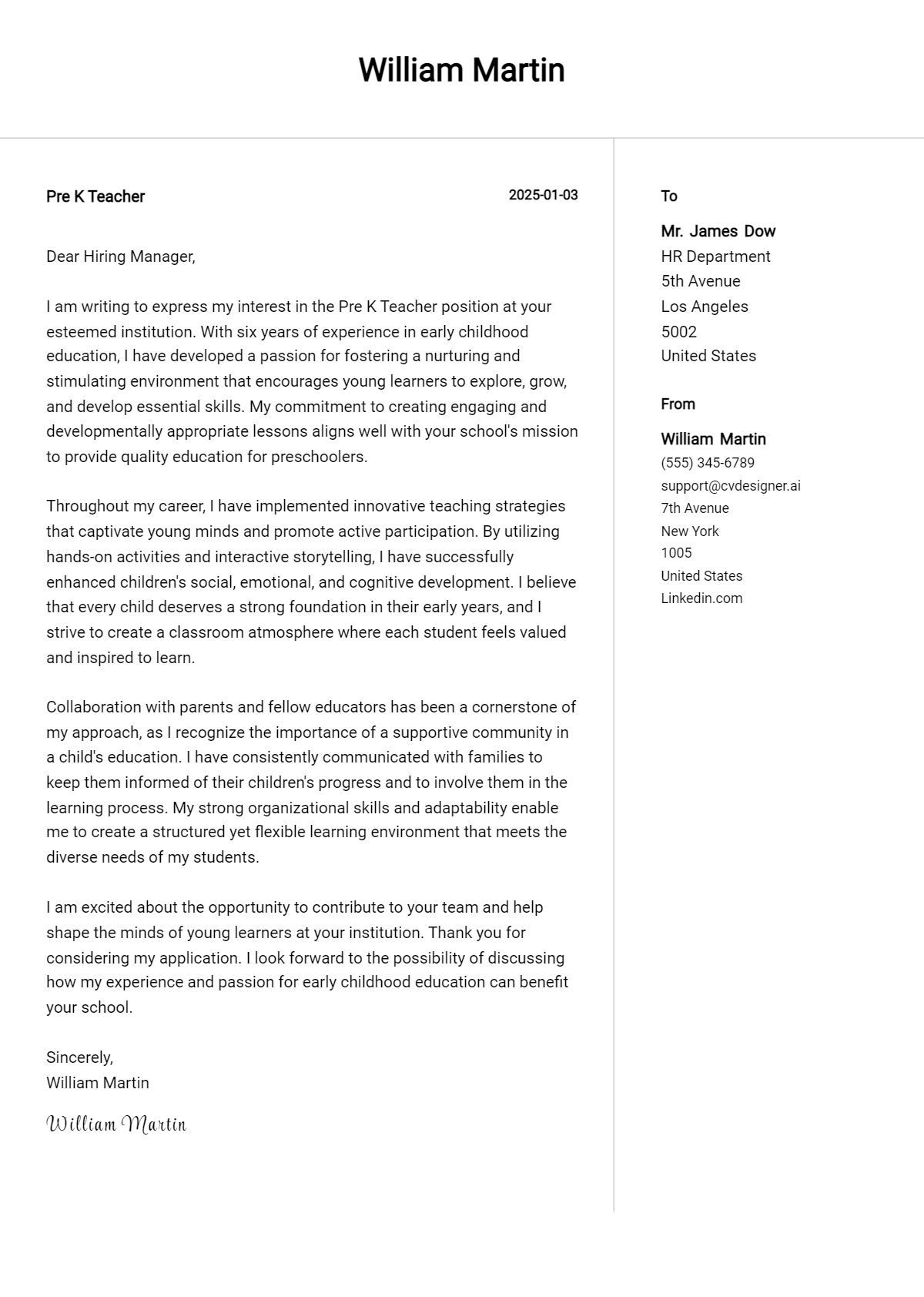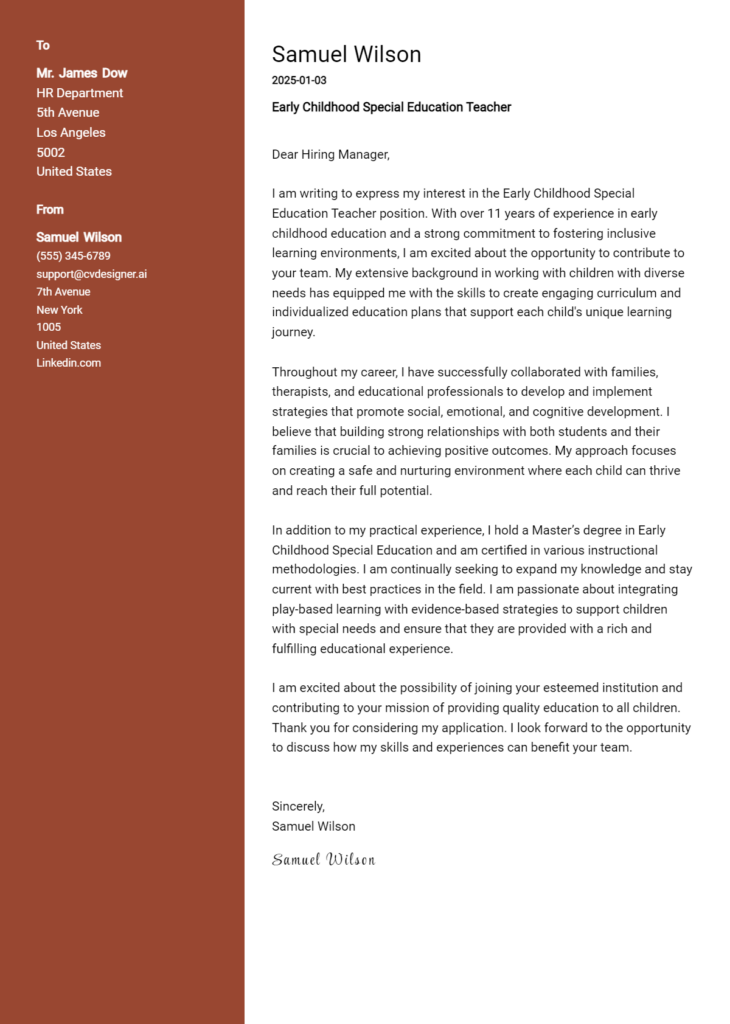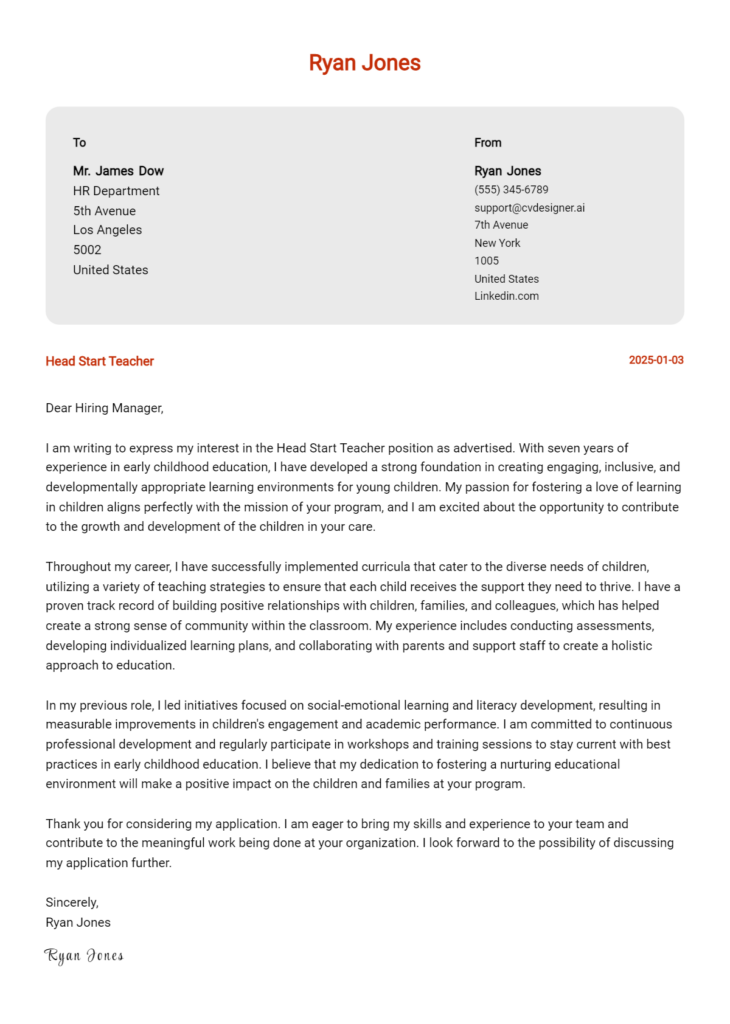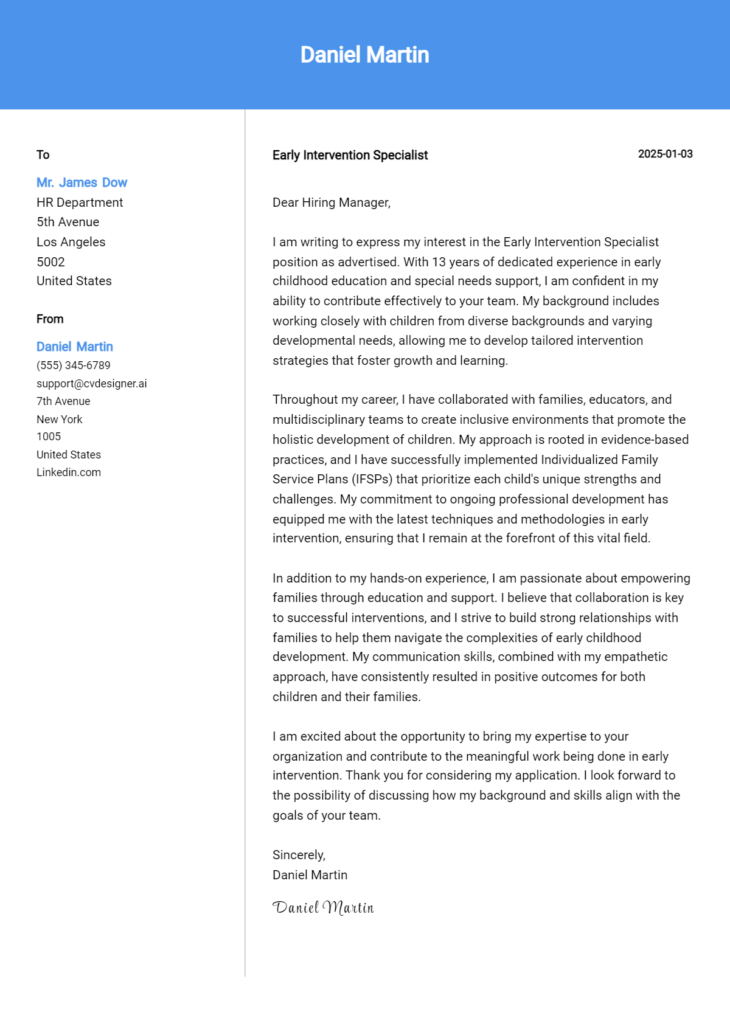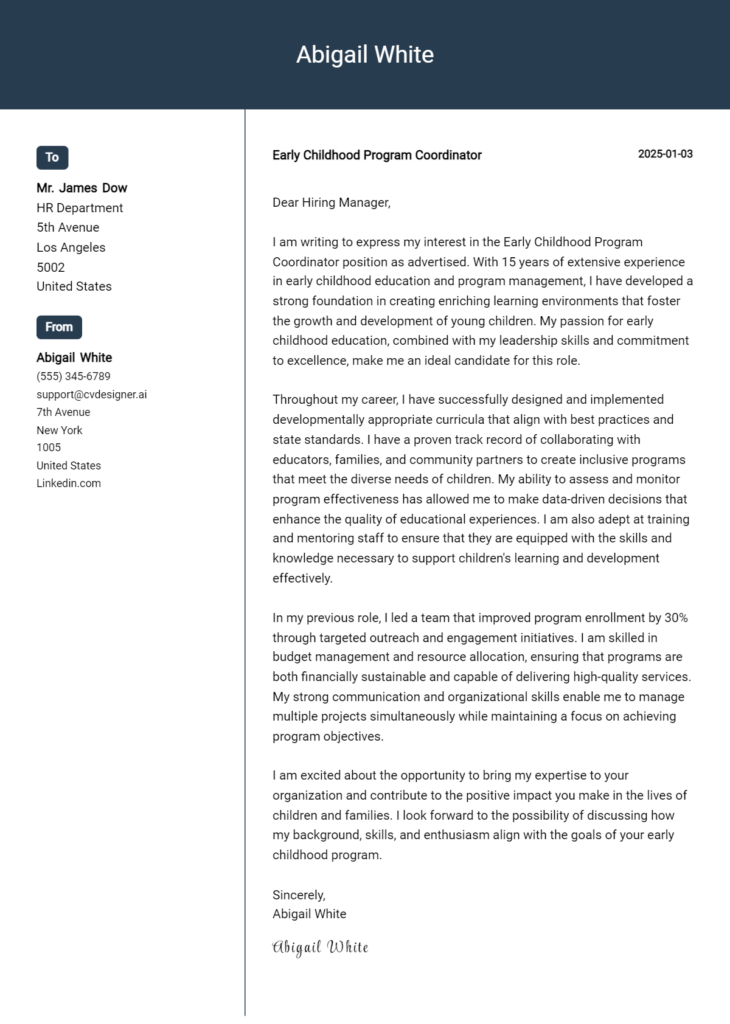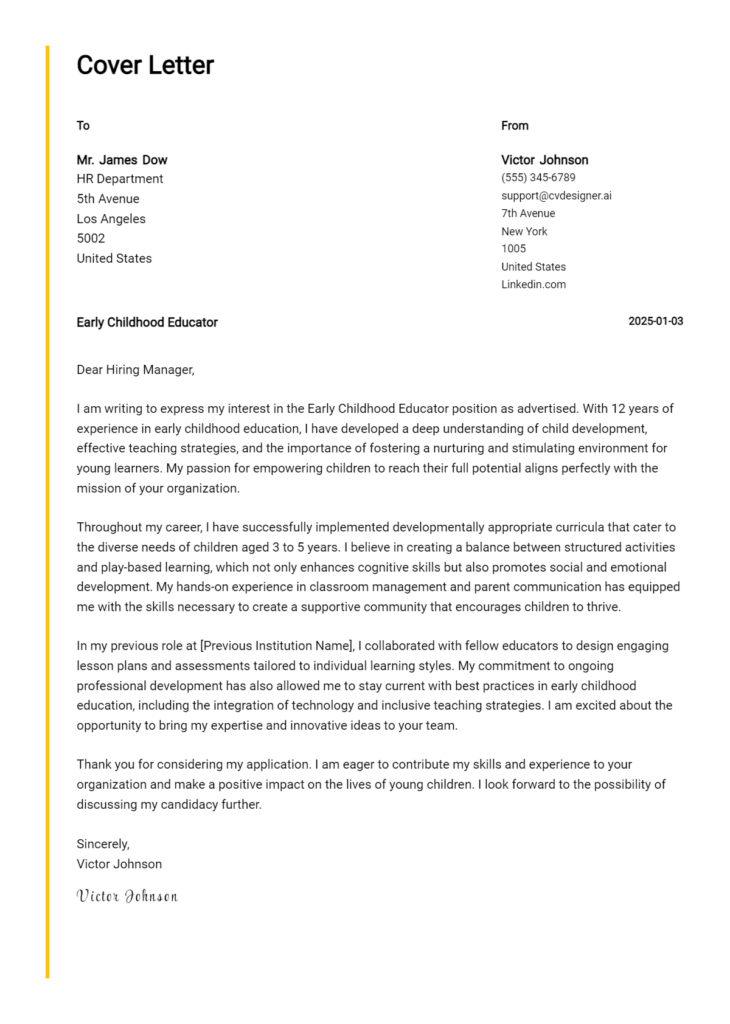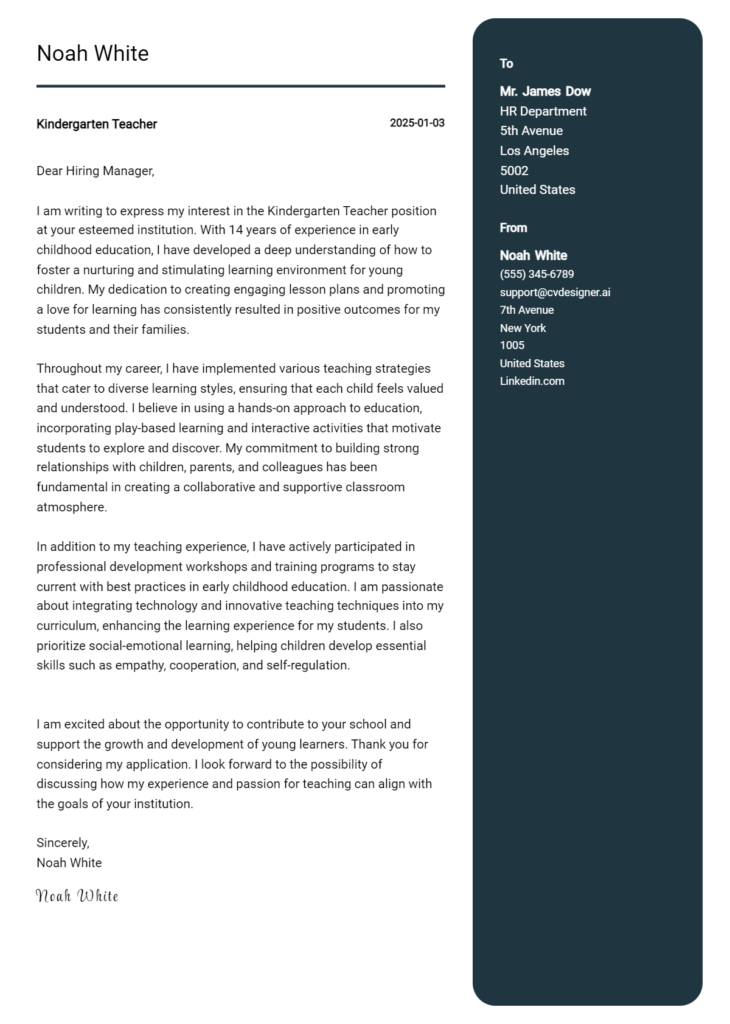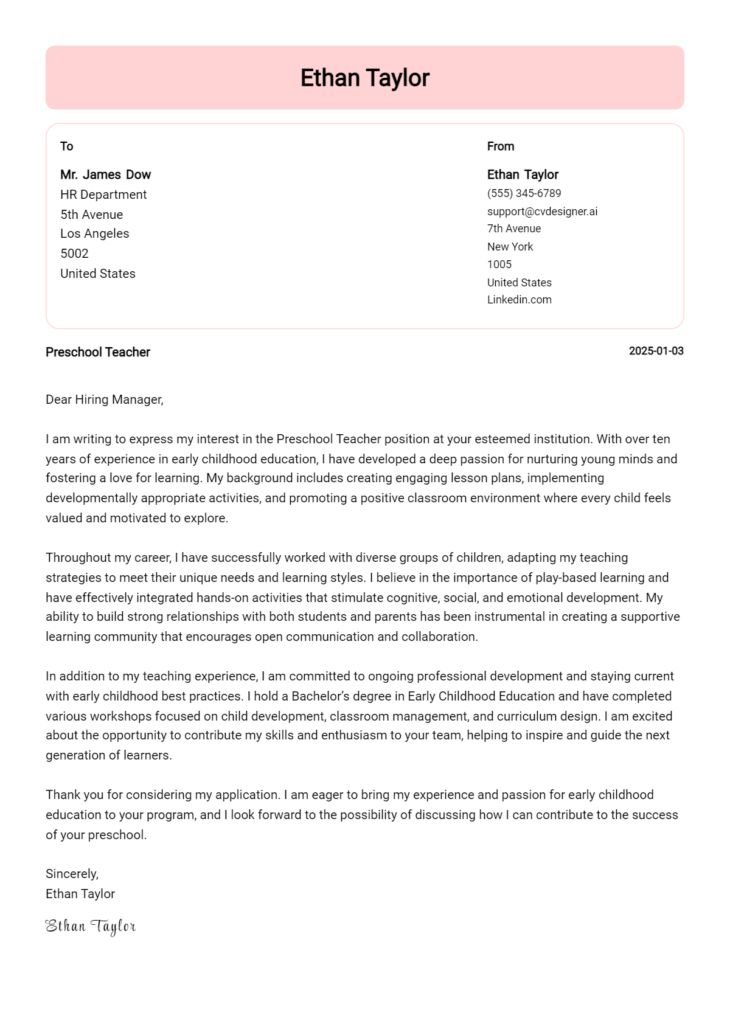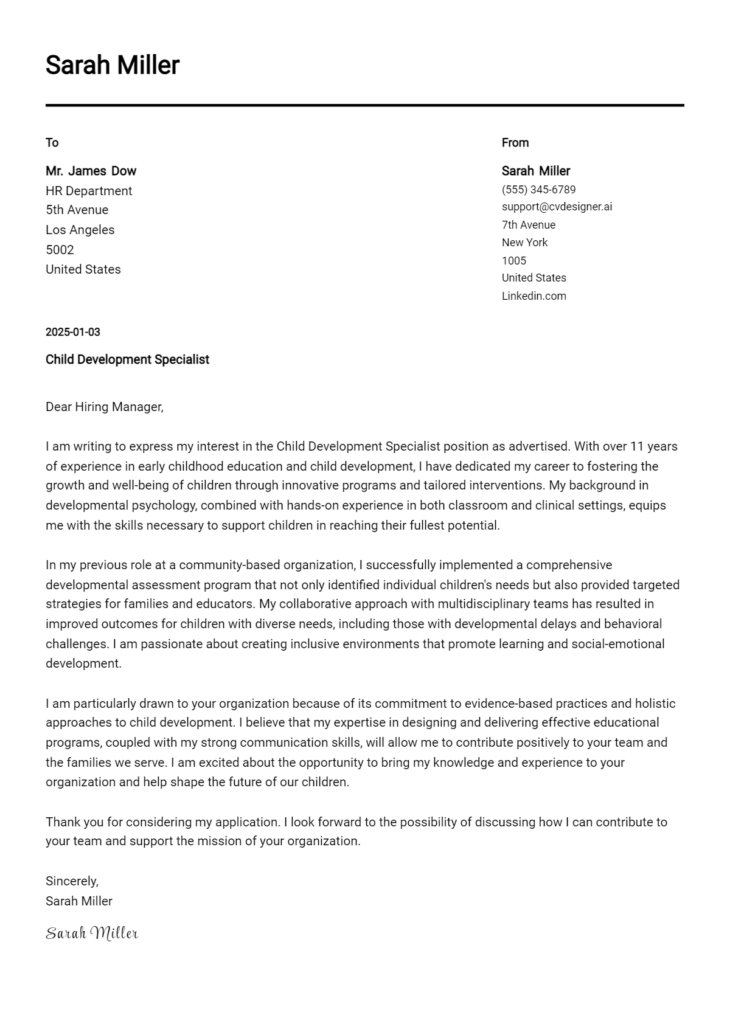Pre K Teacher Cover Letter Examples
Explore additional Pre K Teacher cover letter samples and guides and see what works for your level of experience or role.
How to Format a Pre-K Teacher Cover Letter?
Creating a well-structured cover letter is essential for a Pre-K Teacher, as it not only showcases your teaching philosophy and passion for early childhood education but also reflects your ability to communicate effectively. The format of your cover letter plays a significant role in making a positive first impression on hiring managers, allowing you to illustrate your creativity and nurturing nature—qualities vital in a classroom setting.
In this guide, we will discuss how to format your cover letter, providing insights and examples tailored for Pre-K educators.
We will focus on the key components of an effective cover letter, including:
- Cover Letter Header
- Cover Letter Greeting
- Cover Letter Introduction
- Cover Letter Body
- Cover Letter Closing
Each section is crucial in presenting your qualifications and enthusiasm for teaching young children. Let’s break down each part to help you craft a standout cover letter for your Pre-K teaching application.
Importance of the Cover Letter Header for a Pre-K Teacher
The cover letter header is a crucial component of any job application, including for a Pre-K Teacher position. It provides essential information that allows the recipient to identify the sender and understand the context of the application at a glance. A clear and professional header typically includes the teacher's contact information, the date, and the recipient's details. This layout not only demonstrates attention to detail but also sets a positive tone for the rest of the application. A well-crafted header enhances the overall professionalism of the cover letter, making it more likely to capture the hiring manager's attention.
Strong Example
Jane Doe 123 Elm Street Springfield, IL 62701 (555) 123-4567 jane.doe@email.com October 1, 2023 Mr. John Smith Director of Early Childhood Education ABC Preschool 456 Maple Avenue Springfield, IL 62701
Weak Example
jane doe October 1st 2023 abc preschool
The Importance of a Cover Letter Greeting for a Pre-K Teacher
The greeting of your cover letter serves as the first impression and sets the tone for the rest of your application. It reflects your professionalism and shows that you are genuinely interested in the position. Addressing the hiring manager directly not only personalizes your letter but also demonstrates your initiative in researching the organization and its staff. Avoiding generic greetings like "To Whom It May Concern" can make a significant difference in how your application is received. Instead, take the time to find out the recipient's name through the school’s website or by calling the administration office. A well-crafted greeting can engage the reader and encourage them to continue to the next part of your letter.
Strong Greeting Example
Dear Ms. Johnson,
Weak Greeting Example
To Whom It May Concern,
Cover Letter Introduction for Pre-K Teacher
A well-crafted cover letter introduction is crucial for a Pre-K Teacher as it serves as the first impression to the hiring manager. This introduction should not only capture their attention but also clearly express the candidate's enthusiasm for the role. It’s an opportunity to briefly showcase key skills or achievements that align with the position, setting the tone for the rest of the letter. An effective introduction can make a significant difference in the hiring process, distinguishing a candidate from others by highlighting their passion for early childhood education and unique qualifications.
Strong Example
Dear [Hiring Manager's Name], As an enthusiastic and dedicated Pre-K Teacher with over 5 years of experience fostering a love for learning in young children, I am thrilled to apply for the position at [School/Organization Name]. My commitment to creating a nurturing and engaging classroom environment, combined with my expertise in developing age-appropriate curricula, has consistently resulted in improved student outcomes and joyful learning experiences. I am excited about the opportunity to contribute to your esteemed institution and support the growth of each child in my care.
Weak Example
To Whom It May Concern, I am writing to apply for the Pre-K Teacher position. I have worked with children before, and I think I would be a good fit. I like teaching, and I have some experience in a classroom setting. I hope you consider my application.
Purpose of the Cover Letter Body for a Pre-K Teacher
The cover letter body for a Pre-K Teacher serves as a vital opportunity to highlight the candidate's relevant skills, experiences, and unique contributions to the educational environment. It is an essential part of the application that allows the teacher to showcase their passion for early childhood education and detail specific projects or accomplishments that demonstrate their effectiveness in the classroom. By articulating a clear understanding of child development principles and teaching methodologies, candidates can illustrate how their innovative approaches have successfully engaged young learners, fostered creativity, and promoted social and emotional growth. This section should be tailored to reflect the values and objectives of the educational institution, ensuring alignment between the teacher’s philosophy and the school's mission.
Strong Example
In my previous role at Sunshine Academy, I implemented a hands-on learning project called "Little Gardeners," where my Pre-K students not only learned about plant growth but also took responsibility for nurturing their own plants. This initiative not only enhanced their understanding of nature but also fostered teamwork and responsibility, resulting in a 30% increase in engagement levels, as evidenced by parent feedback. Furthermore, I developed a sensory play area that encouraged exploration and creativity, which significantly improved fine motor skills among my students. I am excited about the opportunity to bring my innovative teaching methods and love for early childhood education to your school.
Weak Example
I have been a Pre-K teacher for a few years and I like to teach kids. I have done some projects, but I don’t remember all the details. I think I would be a good fit for your school because I like working with children and I want to help them learn.
Importance of the Cover Letter Closing for a Pre-K Teacher
The closing paragraph of a cover letter is crucial for leaving a lasting impression on the hiring committee. For a Pre-K Teacher position, it should succinctly summarize your qualifications, reiterate your enthusiasm for the role, and encourage the reader to take the next steps, such as reviewing your resume or scheduling an interview. A strong closing can reinforce your commitment to early childhood education and your readiness to contribute positively to the school environment, while a weak closing may fail to convey your passion or urgency.
Strong Example
Thank you for considering my application for the Pre-K Teacher position at [School Name]. With my background in early childhood education and my dedication to fostering a nurturing and engaging learning environment, I am excited about the opportunity to contribute to your team. I believe that my hands-on experience and creative teaching strategies will positively impact the young learners at your school. I look forward to the possibility of discussing my application further and am eager to schedule an interview at your convenience. Please feel free to review my resume for additional details on my qualifications.
Weak Example
Thanks for reading my letter. I hope you like my resume. I think I would be an okay Pre-K Teacher. If you want to talk more, just let me know.
Common Mistakes to Avoid in a Pre-K Teacher Cover Letter
Crafting an effective cover letter for a Pre-K Teacher position is crucial for making a strong first impression. Avoiding common mistakes can significantly enhance your chances of landing an interview. Here are several pitfalls to steer clear of:
Generic Content: Using a one-size-fits-all approach can signal a lack of genuine interest. Tailor your cover letter to the specific school and position by mentioning their teaching philosophy or specific programs they offer.
Overly Formal Language: While professionalism is important, overly stiff language can come off as insincere. Use a friendly yet professional tone that reflects your personality and passion for teaching young children.
Neglecting Formatting: Poor formatting can make your letter difficult to read. Stick to a clear and organized format, ensuring that your contact information, greetings, and body paragraphs are properly aligned. For tips on how to format a cover letter, check out this cover letter format guide.
Focusing Solely on Qualifications: While it's important to highlight your qualifications, it’s equally essential to convey your passion for teaching and understanding of child development. Share personal anecdotes or experiences that showcase your dedication.
Ignoring Proofreading: Spelling and grammar mistakes can undermine your credibility. Always proofread your cover letter or ask someone else to review it to ensure it’s polished and professional.
Lack of Specific Examples: Vague statements can weaken your appeal. Use specific examples of your teaching experience or successful activities you've implemented in the classroom.
Failing to Include a Call to Action: Concluding your letter without expressing eagerness for a follow-up can be a missed opportunity. Politely indicate your desire to discuss your application further, showing enthusiasm for the role.
By avoiding these common mistakes, you can create a compelling cover letter that stands out to hiring committees. For inspiration, explore some cover letter examples that can help guide your writing process.
Cover Letter FAQs for Pre-K Teacher
What should I include in my cover letter for a Pre-K teaching position?
Your cover letter should include a clear introduction, highlighting your passion for early childhood education. Mention your relevant qualifications, such as degrees or certifications, and any specialized training in child development. It's essential to discuss your teaching philosophy and how it aligns with the school's values. Include specific examples of your experience working with young children, such as lesson planning or classroom management strategies. Conclude with a strong closing statement expressing your enthusiasm for the position and a call to action, inviting the hiring manager to review your resume and discuss your suitability further.
How can I make my cover letter stand out?
To make your cover letter stand out, personalize it for each school or organization by researching their specific values and programs. Use engaging language that reflects your personality and passion for teaching. Incorporate storytelling by sharing a brief anecdote that illustrates your teaching style or a successful experience with students. Highlight unique skills or experiences, such as bilingual abilities or knowledge of diverse learning strategies. Lastly, ensure that your cover letter is well-structured, free of errors, and visually appealing to make a professional impression.
Should I include my teaching philosophy in my cover letter?
Yes, including your teaching philosophy in your cover letter is beneficial, as it gives the hiring committee insight into your approach to education. Briefly articulate your beliefs about how children learn best, the importance of play in early childhood education, and strategies you employ to foster a nurturing and stimulating environment. Be sure to connect your philosophy with the school's mission or educational approach, demonstrating your alignment with their values. A well-explained teaching philosophy can differentiate you from other candidates and show your dedication to the growth and development of young learners.
How long should my cover letter be?
Your cover letter should ideally be one page long, consisting of three to four concise paragraphs. The goal is to provide enough information to capture the hiring committee's interest without overwhelming them. Stick to a clear and professional format, using standard fonts and sizes. Aim for around 250-400 words total, ensuring each sentence adds value and relevance. Remember that hiring managers often review numerous applications, so being succinct while effectively conveying your qualifications and enthusiasm is crucial for making a memorable impression.
Build your Cover Letter in minutes
Use an AI-powered cover letter builder and have your letter done in 5 minutes. Just select your template and our software will guide you through the process.

